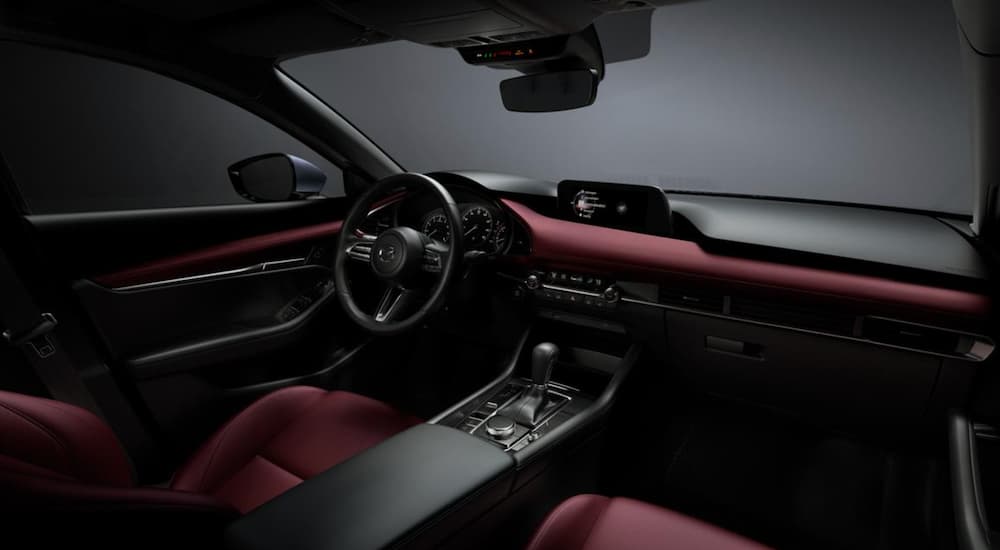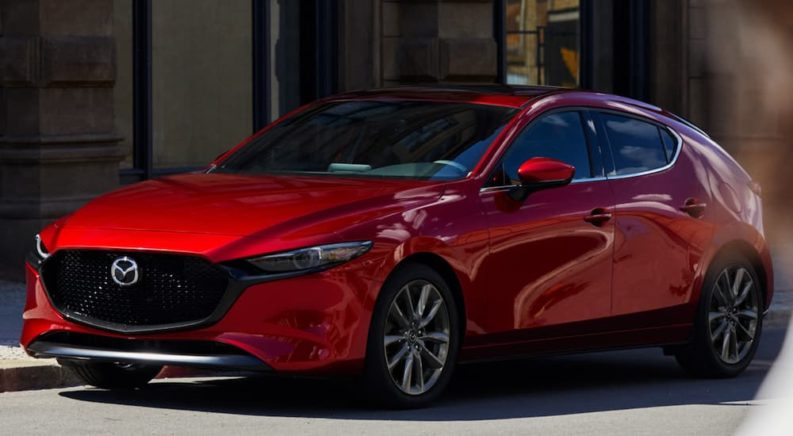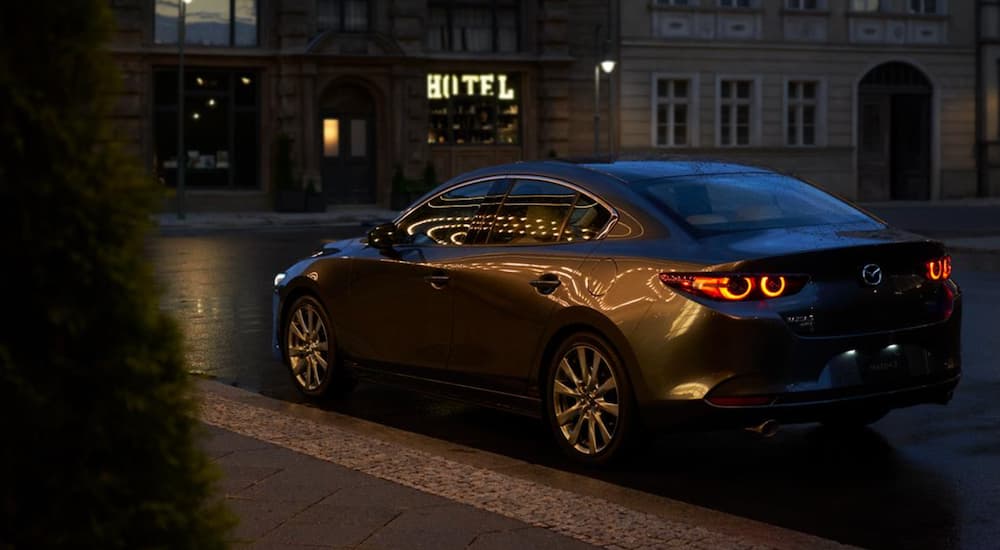For decades Mazda has been at the forefront of automotive design, and you can see it when you visit any Mazda3 dealer. Their portfolio includes some of the most beautiful serial production passenger cars in automotive history. Cars like the classic Cosmo, with its space-age shape and thruster-like tail lights, the timeless RX-7 FD, with its subtly stunning curves, and any generation of MX-5 Miata, with its perennial jubilant character.
These days, Mazda has a chic new overall design language that has been evenly and effectively applied to the car maker’s entire lineup. From the beautifully sleek yet sharp current ND generation MX-5, to the flowing lines of the Mazda6 sedan, to the startlingly sophisticated shape of the Mazda3, Mazda’s design prowess continues unabated.
The Kodo Design Language
Mazda’s current cutting-edge design language is known as Kodo. Often referred to as “Soul of Motion,” this language combines organic flowing lines with a sharp modernity, leading to overall designs that are as erudite and sophisticated as they are poised and athletic. They are not chasing trends, following other carmakers, or attempting to reinvent the wheel. Kodo simply takes the things human beings view as classically and objectively beautiful and slightly sharpens their edge.
All this results in vehicles with flowing, athletic lines that are simple yet dignified and appear both subtle and powerful. Timelessness is a hard thing to achieve in any automotive design for a number of reasons: being beholden to changing trends, intra-company interference, the incredibly high standards required to make a vehicle legal for road use, simple budget limitations, and many more. But Mazda sliced a path through all of that, creating timelessly beautiful designs across their entire lineup that not only visually linked their portfolio of vehicles but made each one the best-looking option in its class. Add the fact that Mazdas are still among the most affordable and reliable vehicles on the road, and the true enormity of what the company has achieved becomes apparent.

Interior Design
Kodo continues into the interior of every current Mazda. But despite being purposefully beautiful, the form of Mazda interiors exists to seamlessly connect the driver to the Mazda’s myriad of functions. The Human Machine Interface of a modern Mazda interior is a triumph of ergonomic science and tactile feel, all wrapped in the same athletic style as the exterior but rendered in soft, comfortable materials.
In many ways, all of this is achieved through the simplest means. Like seat controls being exactly where your hand falls, and the driver being able to control the audio system without a glance or a thought, but just an instinct and the momentary stirring of a finger.
Purposeful, precise, and instinctual control is the intent of Kodo interior design, and Mazda met that goal with aplomb.
Enabling Technologies
Many car makers tout brand new innovations by making them stand out in a car’s design. Mazda, on the other hand, generally prefers to fold in technology seamlessly where it can be used best. This lack of technological overreliance aids the flowing nature of Mazda’s interior and exterior design, partly by adding to the timelessness of it, and partly by simply flowing with the rest of a design.
Good examples of where uncommon or completely new technology has been folded into overall Mazda design include the lightweight wheels used on Mazda6 cars, the high tech multi-layer painting process of the eye-catching Soul Red color, the Heads Up Display available on some models, and the entirely new carbon-neutral bioplastics used in many interior components.
The lightweight alloy wheels available on the Mazda6 incorporate technology first used on racing machines, but the light and strong material’s primary purpose on the Mazda6 is not higher performance. The true reason the lightweight wheels were added to the Mazda6’s design was that they reduced vibration and generally increased driving refinement. Their premium looks and the improved gas mileage, acceleration, and handling, are all additional fringe benefits.
Mazda exterior paint is applied via a new three-layer system that not only improves the depth of shine and color on every Mazda vehicle but reduces the number of pollutants released by the painting process when compared to other car maker’s systems. The new design is among the first to reduce both carbon dioxide emissions and volatile organic compound pollutants.
A technology common to the human-machine interfaces on fighter aircraft is the HUD. The Heads Up Display allows a pilot or driver to see the most vital information about their environment and vehicle in real-time without having to look away from what’s ahead of them. Adding to both safety and style, the Active Driving Display available on many Mazda models helps further strengthen the connection between driver and vehicle.
The high-end plastics used in many Mazda interior parts are actually an industry first, featuring new bioplastics. These plastics allow for excellent texture while maintaining high affordability for the customer, all while being carbon neutral. They represent the cutting edge of interior materials science across the automotive industry.
The Mazda Family
Each individual Mazda model acts as a powerful application of the Kodo design language. Among the robust lineup Mazda has in stock, there are some standouts in style.
Easily and by far the most beautiful compact car on the market, the Mazda3 Hatchback proves that small and inexpensive cars can be elegant and even dignified while remaining intensely athletic. Sports cars and larger sedans are commonly beautiful, generally because their platforms either allow dramatic shapes without the need to account for back seats or because the overall canvas of the design is large enough to perfect a vehicle’s proportions. The Mazda3 manages to look as lithe as a sports car and as graceful as a well-styled large sedan while having none of the built-in advantages of either. Compared to vehicles from other makes, especially from the same compact class, the Mazda3 stands out as a front runner.
The most raced, most successful, and most fun sports car in automotive history is not the fastest. Not the most powerful. And certainly not the most expensive. It’s the one whose handling and styling are most certain to put a smile on your face. That car is naturally the Mazda MX-5 Miata, a car that has millions of fans not just in general but for each generation of the vehicle. Four generations in, the current car is the sharp and exciting ND model. As a perennial roadster, the Miata has always had a simple and compact design, but the current MX-5 RF variant is without any doubt the sleekest series production Miata ever. The folding roof and rear buttresses perfectly complete the taught flowing curves of an already gorgeous design.
The Soul of Motion
The Kodo design language truly is the Soul of Motion. Capturing the essence of physical athleticism and the organically mechanical elegance that comes with it was no mean feat, but the results speak for themselves. Mazda having one of the most beautiful sports cars, which also happens to be one of the most affordable, is no surprise. Mazda building a beautiful and luxurious attainable sedan in the form of the Mazda6 is no surprise. But managing to pen and engineer a practical and imminently usable compact car that looks as good as the Mazda3 is something that needs to be seen to be believed. No matter the vehicle, Mazda design is easily among the best in the world.





